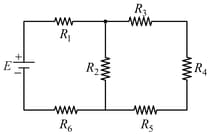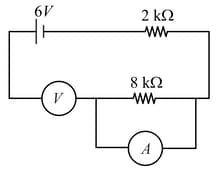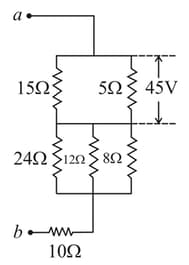MEDIUM
Earn 100
Define drift velocity. On the basis of drift velocity derive Ohm's law ?
Important Questions on Current Electricity
MEDIUM
Though the electron drift velocity is small and electron charge is very small, a conductor can carry an appreciably large current because
EASY
In the figure shown, what is the current (in ampere) drawn from the battery? You are given:

MEDIUM
A current of passes through a copper conductor (resistivity ) of radius of cross-section . Find the mobility of the charges if their drift velocity is .
EASY
A circuit to verify Ohm's law uses ammeter and voltmeter in series or parallel connected corrected correctly to the resistor. In the circuit :
MEDIUM
The resistivity of potentiometer wire is and its area of cross-section is . If current is flowing through the wire, the potential gradient of the wire is
EASY
When a diode is forward biased, it has a voltage drop of . the safe limit of current through the diode is . If a battery of emf is used in the circuit, the value of minimum resistance to be connected in series with the diode so that the current does not exceed the safe limit is :
MEDIUM
To verify Ohm’s law, a student connects the voltmeter across the battery as shown in the figure. The measured voltage is plotted as a function of the current, and the following graph is obtained:

If is almost zero, identify the correct statement:
EASY
is the SI unit of
EASY
A copper wire with a cross-section area of has a free electron density equal to If this wire carries a current of , the drift velocity of the electron is
EASY
In the circuit shown below, a student performing Ohm's law experiment accidentally puts the voltmeter and the ammeter as shown in the circuit below; the reading in the voltmeter will be close to

EASY
A charged particle having drift velocity of in an electric field of , has a mobility in of:
MEDIUM
Ohm's law is applicable to
MEDIUM
A copper wire of cross sectional area carries a current of ampere. The magnitude of the drift velocity for the electrons in the wire, (Assume copper to be monovalent, and density of copper )
MEDIUM
A steady current flows in a metallic conductor of non-uniform cross section. The quantity/quantities that remains/remain constant along the length of the conductor is/are
EASY
characteristic of a copper wire of length and area of cross-section is shown in figure. The slope of the curve becomes

HARD
A voltmeter having a resistance of is used to measure the potential difference across a resistor which is connected to a battery of emf and internal resistance The percentage of decrease in the potential difference across the resistor when the voltmeter is connected across it is
EASY
Find the potential difference between and , as shown in the below circuit.

MEDIUM
The number of free electrons per of ordinary copper wire is . Average drift speed of electrons is . The current flowing is
HARD
Suppose the drift velocity in a material varied with the applied electric field E as . Then graph for a wire made of such a material is best given by:
HARD
When potential difference is applied across a wire of length , the drift speed of electrons is . If the electron density in the wire is , the resistivity of the material is close to:

